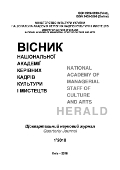INTRODUCTION TO STUDY ON LATE SASANIAN PROTECTIVE HORSE ARMOR
DOI:
https://doi.org/10.32461/2226-3209.1.2018.178365Анотація
Abstract. The principle thought underlying this paper is to characterize general sorts and the advancement of stallion protection utilized by world-class warriors of Sasanian ancient Iran. By investigation and studying about Reliefs, Comos, Terracottas, Grafittos, Seal Impression, Archaeological reports and historical and literary text, we can find oud and realize the Protective Horse Armor in this period. The types of armor protection examined in this paper are included: Scale barding armor, chain mail horse armor, barding composed of multiple elements and fragmentary bardings covering a part of the mount and full lamellar/lamellar barding. The most important part of the Sassanid army was the heavy armored cavalry
(Svaran), which played a crucial role in the wars, especially in the confrontation with the Roman infantry, and it easily collapsed the fighting arrangement and targeted them as beams of riflemen. Many Roman sources have reported that the entire Sassanid horse armored riders were covered with thick iron. It was similar to a ferrous sculpture that was both an instrument of psychological destruction and a shock weapon. Many types of horse-armored riders were formed, such as the Royal Guard. The Sasanians, like their predecessors, used armored riders in almost all battles.
Keywords: Sasanian, Protective Horse Armor, stallion protection
Посилання
Abdullaev K. (1995), Nomadism in Central Asia. The archaeological evidence (2 nd centuries B.C.), [w:] In the
Land of Gryphons. Papers on Central Asian archaeology in antiquity, A. Invernizzi (ed.), Firenze, 151-162.
Abdullaev K. (1995a), Armour of ancient Bactria, [w:] In the Land of Gryphons. Papers on Central Asian
archaeology in antiquity, A.Invernizzi (ed.), Firenze, 163-180.
Ammianus Marcellinus (1935), History. Books 14-19, tr. J.C. Rolfe, London.
Ammianus Marcellinus (1940), History. Books 20-26, tr. J.C. Rolfe, London.
Anderson E. (2011),The Seleucid cataphract. Origins of Armored Cavalry, „Ancient Warfare Magazine”, 5. 6, 34-38.
Bivar A.D.H. (1972), Cavalry Equipment and Tactics on the Euphrates Frontier, „Dunbarton Oaks Papers”, 26, 273-
Brzezinski R., Mielczarek M. (2002), The Sarmatians 600 BC-AD 450, Oxford.
Chudjakov Y. (2006), Die Bewaffung der zentralasiatischen Nomadenvom 3. bis 5. Jh. n. Chr, [w:] Arms and
Armour as Indicators of Cultural Transfer, M.Mode, J.Tubach (ed.), Wiesbaden, 43-78.
Coulston J.C. (1986), Roman, Parthian and Sassanid Tactical Developments, [w:] The Defence of the Roman and
Byzantine East, A.R. Hands, D.Phil, D.R. Walker (ed.), BAR series, Oxford, 59-75.
Crouwel J. H. (2002), Chariots in Iron Age Cyprus [w:] Selected Writings on Chariots, Other Early Vehicles,
Riding and Harness, P. Raulwing (ed.) Leiden 2002, p.146.
Crouwel J.H. (2002b), Ridden Horses in Iron Age Cyprus [w:] Selected Writings on Chariots, Other Early
Vehicles, Riding and Harness,
Daryaee T., Safdari K. (2009), A bulla of the Eran Spahbed of Nemroz, e-Sasanika 8.
Dennis G.T. (1985), Three Byzantine Military Treatises, Washington DC.
Dien A. (1981/82), Study of Early Chinese Armor, „ArtibusAsiae”, XIII, 1/2, 5-66.
Dien A. (1997-2000), The Stirrup and its Effect on Chinese Military History, on www.silk-
road.com/artl/stirrup.shtml as seen on 26-11-2004
Dien A. (2000), Armor in China before the Tang Dynasty, „Journal of the East Asian Archaeology”, 2. 3-4, 23-59.
Dimand M.S. (1940), The Gift of a Sasanian Stucco Relief, „The Matropolitan Museum of Art Bulletin”, 35. 19,
-192.
Eadie J.W. (1967), The Development of Roman Mailed Cavalry, „The Journal of Roman Stud- ies”, 57, 161-173.
Farrokh K. (2005), Sassanian Elite Cavalry AD 224-642, Oxford.
Gall von H. (1990), Das Reiterkampfbild in der iranischen und iranischbeeinflußtenKunst parthischer und
sasanidischerZeit, Berlin.
Ghirshman R. (1973), La Selle en Iran, „Iranica Antiqua”, 10, 94-107.
Goodrich C.S. (1984), Riding Astride and The Saddle in Ancient China, „Harvard Journal of Asiatic Studies”,
2, 279-306.
Goodrich C.S. (1986), The Saddles of the Bronze Horses of Lei-t’ai, „Journal of the American
Oriental Society”, 106. 1, 41-48.
Goroncharovski V.A. (2006), Some Notes on Defensive Armament of the Bosporan Cavalry in the First Centuries
AD, [w:] Arms and Armor as Indicators of Cultural Transfer, M.Mode, J.Tubach (ed.), Wiesbaden, 445-452.
Graff D.A. (2002), Medieval Chinese Warfare, 300-900, London & New York.
Grotowski P. Ł. (2011), ŚwieciWojownicy w SztuceBizantyńskiej (843-1261), Kraków.
Gumilow L. (1972), Dzieje Dawnych Turków, Warszawa.
Gyselen R. (2001), The Four Generals of the Sasanian Empire: Some Sigillographic Evidence, Roma.
Gyselen R. (2008), The Great Families in the Sasanian Empire: some Sigillograpic Evidence, [w:] Current
Research in Sasanian Archaeology, Art and History,
Kennet.D, Luft.P (ed.), BAR Series Oxford, 107-114. Harper P.O. (2006), In Search of a Cultural Identity.
Monuments and Artifacts of the Sasanian Near East, 3 rd th 7 th Century A.D., New York.
Handbook of Byzantine Military Strategy, tr. G.T. Dennis Philadelphia 1984
Hauser S.R. (2006), Was There no Paid Standing Army?, [w:] Arms and Armour as Indicators of Cultural Transfer, M.Mode, J.Tubach (ed.), Wiesbaden, 295-320.
##submission.downloads##
Номер
Розділ
Ліцензія
Автори, які публікуються у цьому журналі, погоджуються з наступними умовами:
1. Автори залишають за собою право на авторство своєї роботи та передають журналу право першої публікації цієї роботи на умовах ліцензії Creative Commons Attribution License, котра дозволяє іншим особам вільно розповсюджувати опубліковану роботу з обов'язковим посиланням на авторів оригінальної роботи та першу публікацію роботи у цьому журналі.
2. Автори мають право укладати самостійні додаткові угоди щодо неексклюзивного розповсюдження роботи у тому вигляді, в якому вона була опублікована цим журналом (наприклад, розміщувати роботу в електронному сховищі установи або публікувати у складі монографії), за умови збереження посилання на першу публікацію роботи у цьому журналі.
3.Політика журналу дозволяє і заохочує розміщення авторами в мережі Інтернет (наприклад, у сховищах установ або на особистих веб-сайтах) рукопису роботи, як до подання цього рукопису до редакції, так і під час його редакційного опрацювання, оскільки це сприяє виникненню продуктивної наукової дискусії та позитивно позначається на оперативності та динаміці цитування опублікованої роботи.

